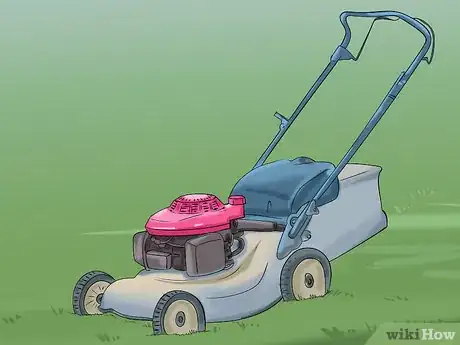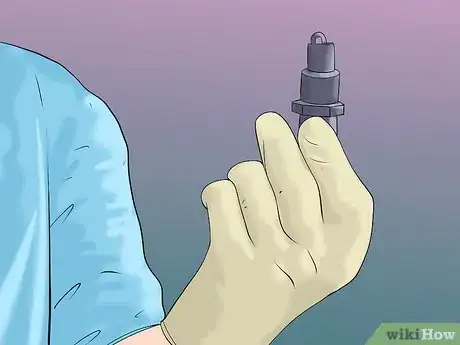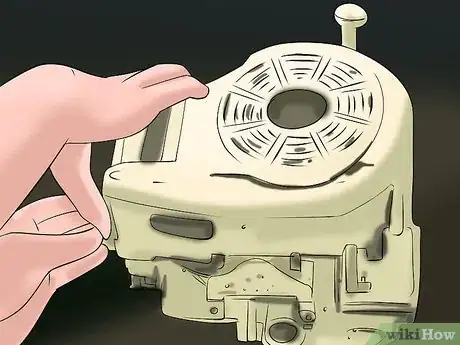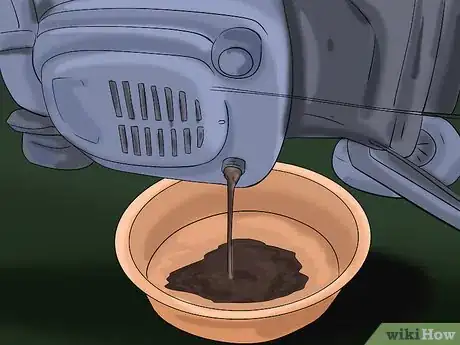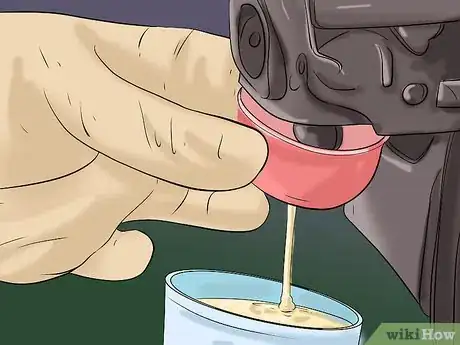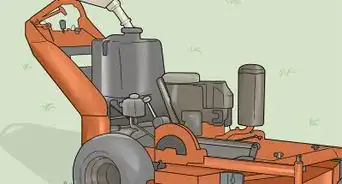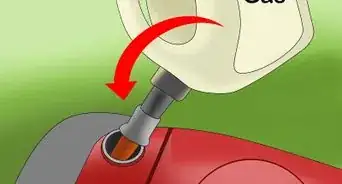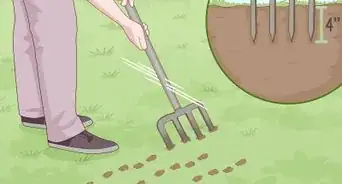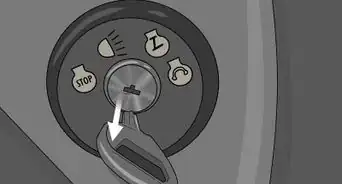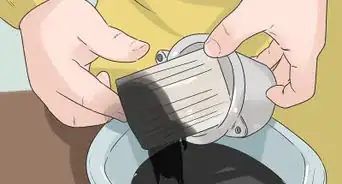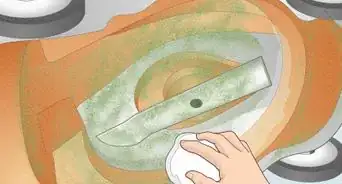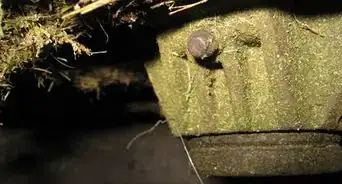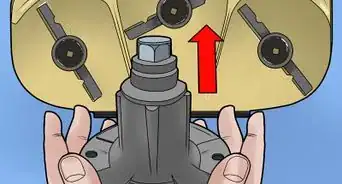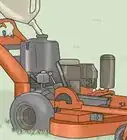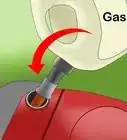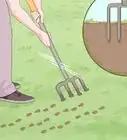This article was co-authored by Grant Wallace. Grant Wallace is a Landscaper and Owner of Grantlanta Lawn in Atlanta, Georgia. With over seven years of experience, he specializes in lawn maintenance and landscape installation. In 2012, he earned his BA from the University of West Georgia. Grant has been profiled in Shoutout Atlanta, Canvas Rebel, and Voyage ATL.
This article has been viewed 311,503 times.
Regular routine maintenance is an important part of caring for your lawnmower. By regularly inspecting for (and repairing) wear and damage, you will improve your lawn mower's performance and extend its life. However, there's no need for you to go to a mechanic every time your lawnmower rumbles strangely. Learn how to fix it yourself! All you should need are some basic tools and some elbow grease.
Steps
-
1Prior to starting, do a close visual inspection, cleaning out any debris, then:[1]
- Tighten or replace any loose nuts / bolts.
- Sand, prime and paint rusted structural parts.
- Replace or coat any bare or frayed wiring connections.
-
2Remove the spark plug lead from the spark plug and move it away from cylinder head. Always do this before attempting any repairs to a lawnmower that require turning the engine. If you can't start it then first check your spark plug.[2]Advertisement
-
3Position your mower. Tip it with care. There is no one rule fits all for tipping two or four stroke engines.
- It is best not to tip, but if you do you should remove the air filter so that it does not become saturated with oil or gas and be prepared for oil and or gasoline spillage! Most mowers now have a fuel line between the carburetor and fuel tank, and it is a good idea to clamp this in some way. Small needle nose vise grips with rubber hose slid over each jaw work great but should clamp only tightly enough to stop fuel flow.[3]
- If your lawnmower is a "four stroke" mower (separate gasoline and oil), never tip it on its side with the spark plug to the ground. Most four strokes have a crankcase vent that routes to the air filter box and will pour or seep oil into the air filter or carburetor throat if they are tipped with the spark plug pointing skyward.
- If your lawnmower is "2 stroke" (oil and gasoline mixed) turn off the fuel tap. You can tip a two stroke mower almost any way that is suitable to you, as long as the fuel doesn't spill from the tank.
- However, be aware that practically all four stroke mower engines have a float type carburetor that can leak fuel if tipped in a particular position relative to how the carburetor is positioned. They can either pour fuel into the air filter or into the combustion chamber, if the intake valve is open.
-
4Change or sharpen the blade, if needed. To change a blade, or blade disc, it is often easier to remove the spark plug and feed a length of clean cotton string into the cylinder head to 'lock' the piston while trying to undo the blade bolt(s).[4]
-
5Check the motor's "air filter" while doing this sort of maintenance. A dirty or clogged air filter will affect engine performance and increase fuel consumption of your mower. Symptoms of a clogged air filter include difficulty starting and quickly stopping after several sputters, or a weak idle. You may also see oily or smoky exhaust.[5]
-
6Change the oil if needed. If your mower is a "four stroke" model, change the oil at least once a year. When it is tipped over with the spark plug in the air, it is a good time to remove the "oil fill" plug and drain oil into a suitable oil proof container for disposal or recycling. Many modern mowers have a drain plug so the mower doesn't need to be tipped.[6]
-
7Be aware of stale fuel. Stale fuel is a common cause of mowers not starting after the winter storage. Run your mower for five minutes every two or three weeks and you will save yourself problems come spring. Using gasoline without ethanol will decrease this problem, as will using a fuel stabilizer.
- Assure you discharge the gas tank by letting the mower run until the fuel is gone. Keep the tank empty until the following cutting season, or, the aged gas that has stayed in the tank all that time will cause moisture and become thick, producing sediments in the gas lines and carburetor, causing the engine to die. Also, make sure you dispose of the aged oil on the tank and change for clean oil.
Expert Q&A
-
QuestionHow do you care for a riding lawn mower?
 Grant WallaceGrant Wallace is a Landscaper and Owner of Grantlanta Lawn in Atlanta, Georgia. With over seven years of experience, he specializes in lawn maintenance and landscape installation. In 2012, he earned his BA from the University of West Georgia. Grant has been profiled in Shoutout Atlanta, Canvas Rebel, and Voyage ATL.
Grant WallaceGrant Wallace is a Landscaper and Owner of Grantlanta Lawn in Atlanta, Georgia. With over seven years of experience, he specializes in lawn maintenance and landscape installation. In 2012, he earned his BA from the University of West Georgia. Grant has been profiled in Shoutout Atlanta, Canvas Rebel, and Voyage ATL.
Landscaper Make sure you store it somewhere out of the rain (under some sort of cover is a great idea). Also, be sure to remove any gasoline from your mower when you don't plan on using it for a long time (like in the winter months)—keeping gas inside of any type of lawn equipment for a long period of time isn't good for the engine.
Make sure you store it somewhere out of the rain (under some sort of cover is a great idea). Also, be sure to remove any gasoline from your mower when you don't plan on using it for a long time (like in the winter months)—keeping gas inside of any type of lawn equipment for a long period of time isn't good for the engine. -
QuestionI'm unable to start my lawn mower because the gas has sat too long. What can I do?
 Community AnswerTip the mower back onto the handle for 20 seconds. This will drain the fuel bowl and fuel line. Then, turn the mower on its side to dump out the old gas. Refill with fresh gas and you're good to go.
Community AnswerTip the mower back onto the handle for 20 seconds. This will drain the fuel bowl and fuel line. Then, turn the mower on its side to dump out the old gas. Refill with fresh gas and you're good to go. -
QuestionHow do I clean dried grass from a plastic mower?
 Community AnswerWith soap and water, or dish washing liquid. You basically just need to degrease the area. You may need to scrub in order to remove any attracted debris.
Community AnswerWith soap and water, or dish washing liquid. You basically just need to degrease the area. You may need to scrub in order to remove any attracted debris.
Warnings
- Watch out for old blades when changing them. They can have razor sharp edges.⧼thumbs_response⧽
- Always remove spark plug lead before attempting any repairs on your mower.⧼thumbs_response⧽
- If you should ever feel a sharp resistance when you pull the starter rope and especially if it snatches the handle out of your hand, stop. Remove the spark plug and inspect it. If it is wet then the engine has become flooded due to the way you tipped the mower. With any possible control in the off position, and the spark plug lead secured so that it cannot possibly jump a spark to metal, and after moving the mower to a safe location, slowly pull the starter a few times to 'blow' out the excess fuel. Dry the plug, install it and try again to start the mower. If the plug was not fouled, try re-tightening the blade; as always with the spark plug lead removed and secured away from the plug. If you still feel a sharp rebound or handle snatch (and this can hurt you) then you almost certainly have a sheared flywheel key.⧼thumbs_response⧽
- Tightening or loosening a blade bolt can be dangerous. you may hurt yourself. If you do not tighten the blade securely enough, the engine is likely to shear its flywheel key as soon as it tries to run. It will immediately shut down and will not run again until the key has been replaced.⧼thumbs_response⧽
- Never touch any internal-combustion engine while it is warm, After operating, some components may reach temperatures up to 1,200 °F (649 °C).⧼thumbs_response⧽
Things You'll Need
- Spark plug spanner (socket wrench). Usually a 14, 15, or 17 mm (usually a 3/4" in North America) wrench for blade bolts/nuts. 8 mm or 5/16" socket for air filter 'nut'. 600 milliliters (20.3 fl oz) (1 imperial pint or 20 U.S. fl oz) SAE-30 oil for the average mower engine oil change. (4 - 6 Hp).
Expert Interview
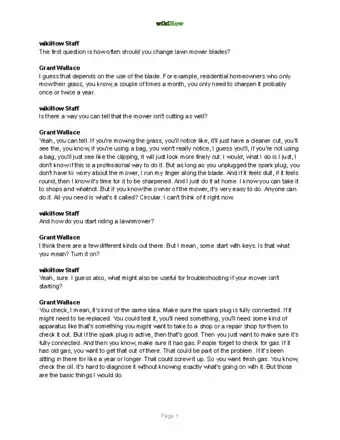
Thanks for reading our article! If you'd like to learn more about lawn mower maintenance, check out our in-depth interview with Grant Wallace.
References
- ↑ https://www.youtube.com/watch?v=DRv1Ne_8lIY
- ↑ https://www.todayshomeowner.com/how-to-change-a-lawn-mower-spark-plug/
- ↑ http://diy.repairclinic.com/2013/07/01/what-to-do-if-you-tip-over-your-lawn-mower-and-then-it-wont-start/
- ↑ https://www.consumerreports.org/lawn-mowers/how-to-remove-and-replace-a-lawn-mower-blade-a1128582899/
- ↑ https://www.youtube.com/watch?v=lsvn2VQaQBw
- ↑ https://www.youtube.com/watch?v=2aMsu6gerBo
